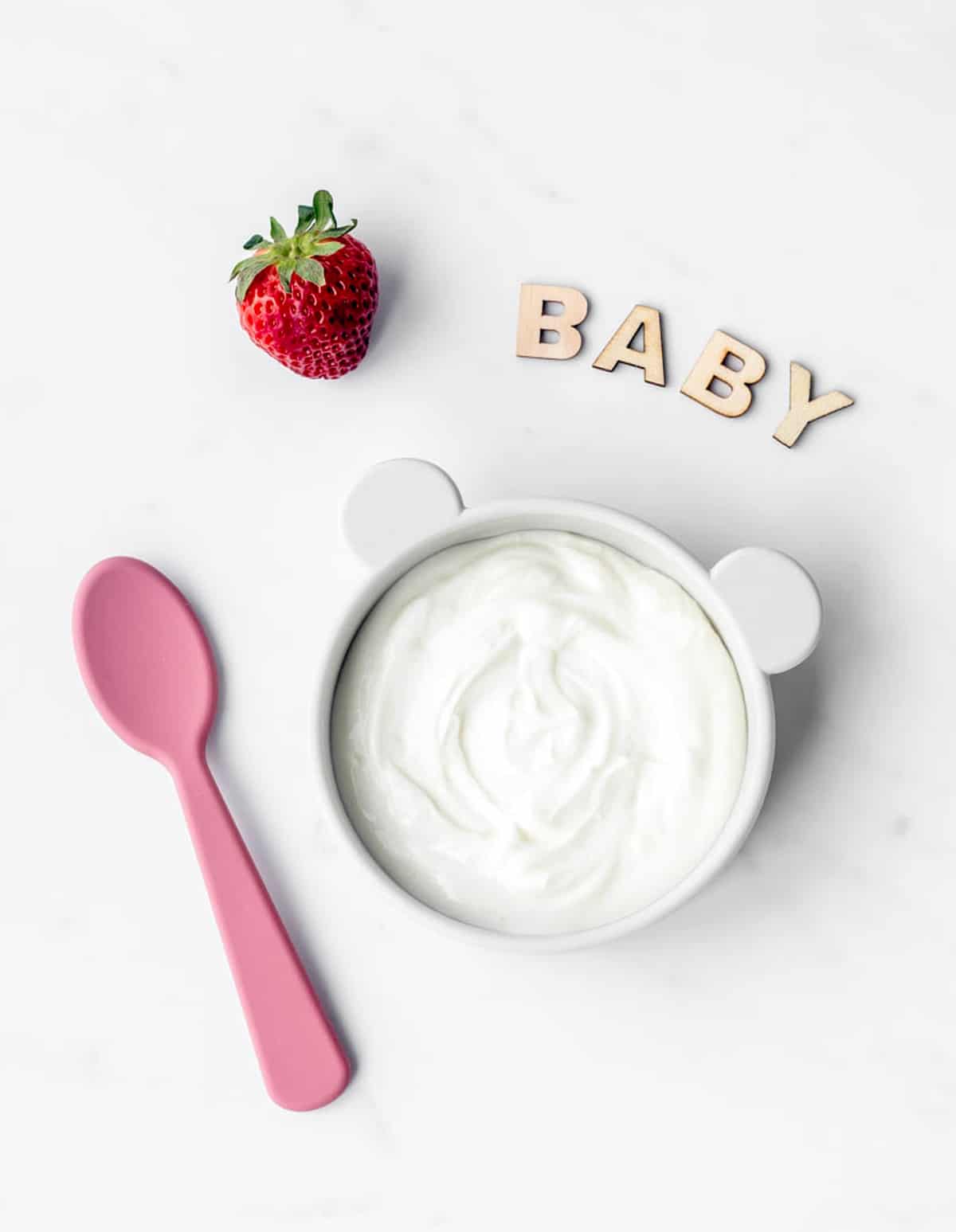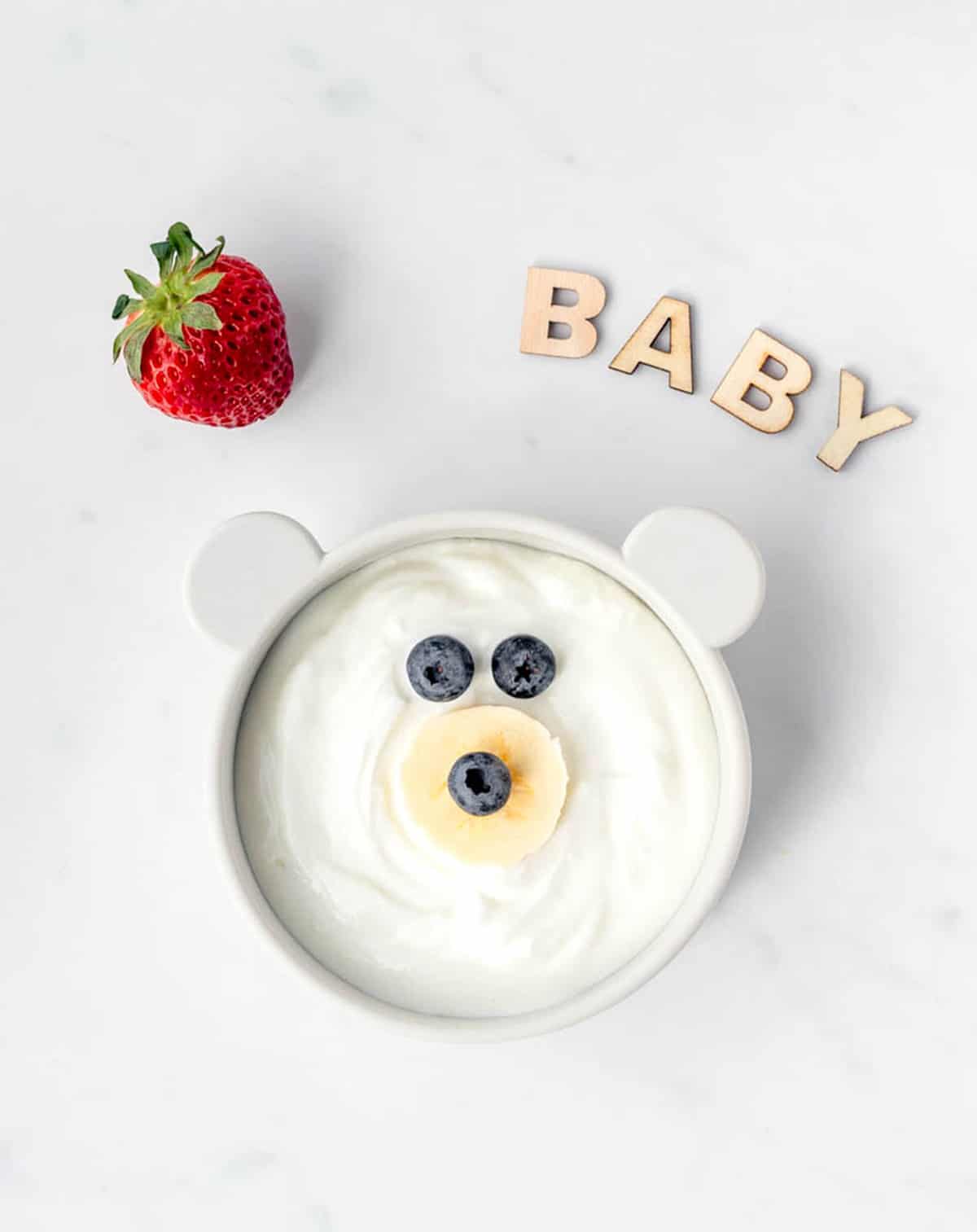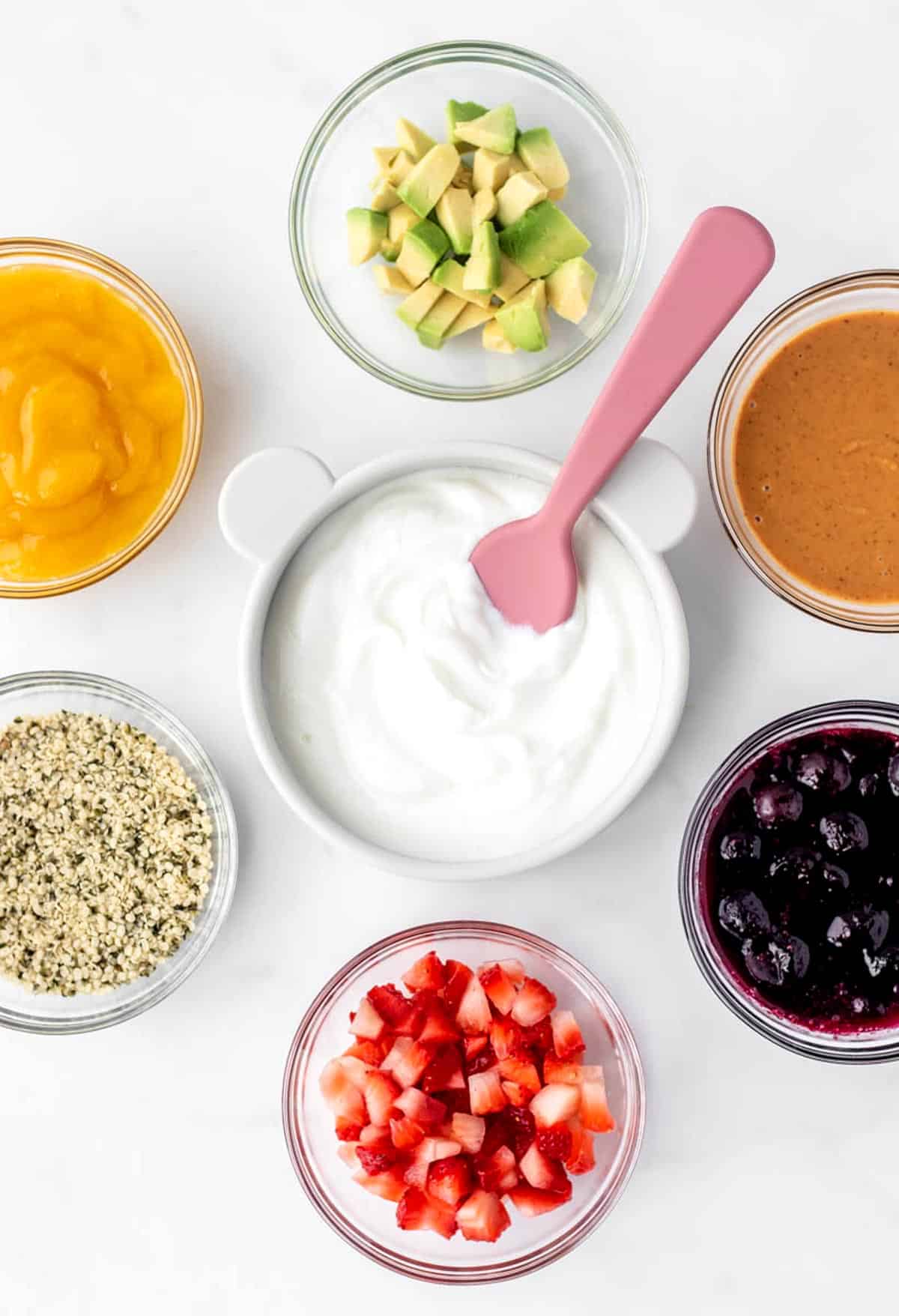As an Amazon Associate I earn from qualifying purchases. I get commissions for purchases made through links in this post.
Confused about how to how to choose the best yogurt for babies? Take the guesswork out of navigating those oftentimes confusing grocery store shelves with these helpful tips. Get recommendations on what type of yogurt to look for, how to serve yogurt to babies and more!

Best Yogurt for Babies
The best yogurt for babies is one that supports their overall development and provides energy to allow them to keep exploring and learning. Not all yogurts are a good choice for your little one, so follow these tips to find the right yogurt for your baby.
If your baby is starting to eat solid foods, yogurt is a great option! It’s high in protein, fat-soluble vitamins, probiotics, and healthy fats, and it’s a great way to introduce dairy to help avoid food allergies.
However, if you’ve been to a grocery store lately, you know many different types of yogurt are available.
- Which one is the best choice for babies?
- Can babies have dairy-free yogurts?
- Is Greek yogurt better than regular yogurt?
I’ll answer all that and more so you know which option is best for your little one.

What’s the best yogurt for babies?
Since babies’ brains grow so much in their first year of life, it’s essential to choose a full fat unsweetened yogurt. Skip the skimmed milk or 2%; they do not have enough fat to support your baby’s brain development.
It’s also important to avoid yogurt with added sugar. When babies first start on solids, they don’t need the extra sugar. In fact, the CDC recommends that children under the age of 24 months avoid added sugar altogether (source). The good news is that there are plenty of sugar-free, whole-food options to sweeten yogurt naturally.
Focus on plain whole milk yogurt and add your baby’s favourite fruits or vegetables to make it even more nutritious and filling.
When can babies eat yogurt?
Most babies start eating solid foods at around six months of age. At this time, you can gradually introduce yogurt into their diet.
Start with small amounts to help your baby’s digestive system get used to consuming cow’s milk and the active cultures in yogurt.
Once your baby is comfortable eating yogurt, they can enjoy 1/4 – 1/2 cup daily.
Is yogurt healthy for babies?
Yogurt is a great first food to add to your baby’s diet!
Yogurt is naturally high in:
- Nutrients like calcium, vitamin D, B12, and more
- Protein to grow muscles and a healthy metabolism
- Probiotics to support gut health and develop a strong immune system
- Fats to promote healthy brain development

Plus, introducing yogurt at an early age can help babies avoid developing a milk allergy later on. New evidence shows that babies should be exposed to common allergens like dairy and peanut butter between 4-6 months of age to reduce the likelihood of developing an allergy (source).
If you’re worried about how your baby might respond to cow’s milk, many people with lactose intolerance can still tolerate yogurt (source). This is because the heating and culturing process reduces the allergens found in lactose.
Yogurt is a healthy food for your baby’s first year and has many benefits to promote your baby’s well-being. However, it’s important to note that although cow’s milk can be incorporated into various recipes, babies should not have regular cow’s milk as their primary beverage until at least 12 months old (source).
Stick to cultured dairy like cheese, yogurt, and cottage cheese until they are one year old.
What to Look for in a Yogurt for Baby
Your favourite yogurt might not be a good option for your baby just yet. It’s important to look for unsweetened full-fat yogurt made with whole milk. Babies do not need extra sugar, but they do need fat.
You could even give your baby cream-top yogurt, which has more fat than regular yogurt.
When it comes to organic yogurt vs. non-organic yogurt, organic dairy products may be higher in omega-3 fatty acids and have higher amounts of iron, vitamin E, and some carotenoids than regular yogurt (source, source, source), but may also contain less selenium and iodine (source).
Additionally, a quart of plain organic yogurt can be a bit more pricey and usually costs about $5-6, but since you’ll need so little of it at a time, one container will last a while. Whether you opt for organic or conventional dairy products is completely a personal preference.
In terms of flavour, check the ingredient list if you’re trying to choose between plain or vanilla yogurt. Although it’s okay for babies to have vanilla, most vanilla yogurts are highly sweetened. It’s better to sweeten yogurt with real fruits or vegetables (see below for some suggestions)!
Greek vs Plain Yogurt for Babies
Babies can have either Greek yogurt or regular yogurt, but each option has pros and cons.
First, Greek yogurt is higher in protein and lower in whey, which may make it easier for babies to digest. It’s also thick and can stick to a spoon (or messy fingers) for easier eating. Since Greek yogurt is tangier than regular yogurt, your baby might not like it immediately.
Regular yogurt has less protein than plain Greek yogurt, and because it is so thin, it can be challenging for babies to eat it on their own. Supplement it with pureed fruits or vegetables to thicken the texture and add extra flavour.
The best choice depends on your little one. If they can tolerate the tangy flavour of Greek yogurt, it’s typically more nutritious and easier for babies to eat.

Best Yogurt for Babies at 6 Months
Focus on plain, unsweetened Greek or regular yogurt. Choose a pasteurized yogurt and check the ingredients list to avoid added sugar or artificial sweeteners.
Look for some of these brands at your local grocery store:
- Stonyfield organic whole milk yogurt
- Maple Hill organic cream top plain yogurt
- Amy’s organic whole milk yogurt
- Amy’s plain organic grass-fed yogurt
- Zoi plain Greek yogurt
- Chobani plain Greek yogurt
- Fage 5% Greek yogurt
- Wallaby plain whole milk Greek yogurt
Plant-Based Yogurts for Babies
At this point, you might be wondering if non-dairy yogurts are a good option for babies. Yes! Plant-based yogurts are an excellent choice for babies, especially if they have issues tolerating dairy products.
If you are considering plant-based yogurts due to a fear of an allergic reaction, I recommend consulting your child’s pediatrician to get their medical advice. Our understanding of allergens is changing; even if the baby’s parent or sibling has a dairy allergy, your baby may not.
Just like choosing the right cow’s milk yogurt, plant-based yogurt should be full-fat, unsweetened, and cultured.
The digestive health benefit of yogurt comes specifically from the culturing process. Most non-dairy yogurts contain active live cultures, but not all of them. Double-check that the yogurt you choose says that it includes “active live cultures” to ensure it has the beneficial bacteria to support your baby’s microbiome.
Some good dairy-free yogurt choices include:
- SODelicious plain coconut milk yogurt
- Forager unsweetened cashew milk yogurt
- Kite Hill unsweetened almond milk yogurt
Other non-dairy milks are safe for babies to eat but might not contain as much fat as they need. For example, oat milk yogurt is naturally low in fat. It has 1.5 grams of fat per 6 oz serving, whereas plain yogurt is usually about 5-6 grams.
Since non-dairy milks do not include protein or calcium like regular milk, choose fortified non-dairy yogurts or plan on meeting those nutritional needs elsewhere.
Should I buy yogurt made for babies?
Although you might see yogurt made for babies in your yogurt aisle, don’t fall for the marketing hype. Those products are typically overpriced and contain unnecessary sugar to make the taste more appealing to little ones.
It’s better to buy a large container of plain unsweetened yogurt and portion out what you need each time. This will reduce your cost and waste while ensuring your baby isn’t consuming unnecessary sugar.
5 Great Ways to Flavour Plain Yogurt
Although yogurt is a good choice on its own, it’s even tastier mixed with some fruits and other toppings. Here are some of my favorite mix-ins:
- Diced or pureed fruits (sweet mango puree, strawberry, apple, banana all work well)
- Thawed frozen wild blueberries (dump them right into the yogurt and allow them to thaw)
- Chopped avocado
- Mashed vegetables (carrots, sweet potatoes, squash)
- Nut butters like natural peanut butter or almond butter
- Ground hemp seed or flaxseed (great for reducing constipation!)

How to Serve Yogurt to Babies
There are plenty of ways to feed your baby yogurt, and you can get really creative with it!
- Give them a bowl of yogurt to eat with their fingers
- Pass them a preloaded spoon
- Add it to a reusable squeeze pouch
- Make a batch of baby-safe popsicles
- Let them dip toast, pancake or waffle strips into it
- Freeze drops of yogurt to make easy-to-hold yogurt melts
- Spoon it into some oatmeal, or try adding some to these BLW overnight oats
- Bake yogurt into cakes, muffins and breads
- Mix it into scrambled eggs (like these scrambled eggs for baby)
- Blend it into dips or smoothies

Clearly, yogurt is one of the best new foods to feed your baby as it has many health benefits and is ideal for reducing your baby’s risk of developing allergies or even eczema (source).
Always consult with your doctor or pediatrician before switching your baby to solid foods, and be sure to ask about yogurt at your next appointment if you have any questions or concerns!







